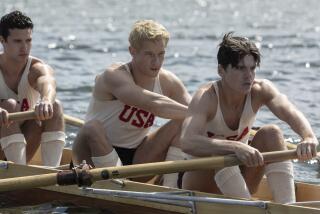Olympian Turns Near-Tragedy Into a New Course for His Life
- Share via
When Cliff Meidel talks about getting a big jolt in his life, he’s not talking in metaphors.
After an accident sent more than 30,000 volts of electricity through his body, the young athlete lost the use of his legs. And if not for that loss, the Manhattan Beach native would probably have never found the upper-body strength that earned him a spot as the newest member of the U.S. Olympic men’s kayak team.
“I can look back at the accident now and realize that it built me up as an athlete and an individual,” Meidel said. “If I didn’t have the accident, I wouldn’t be who I am today.”
Ten years ago, Meidel was working as a plumber in training when he accidentally drilled through three electrical cables. The near-fatal accident stopped his heartbeat three times, and when Meidel finally regained consciousness doctors told him his legs were so severely damaged that they would have to be amputated.
“At the time we didn’t think he would make it,” said Meidel’s father, Helmut, who remembers overhearing doctors talk about how serious his son’s condition was while riding in the elevator at Robert F. Kennedy Medical Center in Hawthorne.
An avid surfer and soccer player, Cliff Meidel was strong and at 20 had good circulation in his feet. Doctors decided they could save his legs by putting muscle fibers from his calves onto his knees. After the surgery he was confined to a wheelchair and was told chances were slim that he would walk again.
But six months later Meidel was on crutches and in six more months he was climbing into a canoe. While paddling with the Redondo Beach-based Lanakila Outrigger Club, Meidel learned that although his legs were weak his arms were still strong. And if he channeled the power in his upper body through the waves that carried the canoe across the horizon, he could become a great paddler.
A strong-willed athlete who worked summers as a junior lifeguard for the county, Meidel pushed himself to win races on the outrigger canoe circuit. His success motivated him to strengthen his legs, even though a third of his knee tissue was missing. He was determined to walk without crutches and within two years of the accident he did, although he still requires braces at the knee.
Though he started paddling in a canoe, Meidel took an interest in kayaking after the 1992 Summer Olympics. Inspired by kayaker Greg Barton, who recovered from a foot disorder at birth, Meidel set his sights on the Olympics.
Three weeks ago, Meidel’s decade of hard work paid off. The lean rower qualified for the final spot on the U.S. Olympic canoe and kayak team and will race July 30 and Aug. 1 in the Olympic 1,000-meter four-man kayak event, in which he hopes to be a part of the first team to win a medal in four-man competition.
“It was always a dream to be a great athlete and to be recognized by my country in the Olympics, and now it’s happening,” Meidel said after an early morning practice with the team at the Olympic Training Center in Chula Vista near San Diego. “I feel such an incredible sense of excitement.”
He is the rookie in a boat of veterans--Phlippe Boccara of San Diego, Curt Bader of Bloomfield, Iowa, and Mark Hamilton of Louisville, Ky.--all of whom have at least two Olympic experiences under their belt. And at 30, Meidel is also the youngest in the kayak.
Inside the narrow boat, he sits in seat two--behind the stroker, who sets the pace of the windmill-like stroke that the kayakers create when their blades cut through the water. Meidel’s teammates have affectionately nicknamed him “Volt Boy” for the charge he got in the accident. But his coach says the nickname could describe the power the 6-foot-3 athlete brings to the four-man vessel.
“Cliff is the main piston in the boat,” assistant coach Jerzy “George” Dziadkowiec said after a high-intensity workout in which the kayakers practiced starts for the upcoming Olympic sprint. “He’s in very good shape and is one of the strongest on the team.”
For the past three months the paddlers have been practicing the synchronized stroke in conjunction with speed drills, four hours a day, six days a week. Though Meidel only officially made the team three weeks ago, he has been practicing with the Olympians as an alternate since March.
It’s during the cross-training sessions that Meidel is reminded of his injury. Three days a week the team lifts weights and then runs for two hours. Meidel pumps iron with the team but stays in the gym when his cohorts head to the track.
Running puts too much pressure on his joints, so he works out on a stationary bicycle. He joins the team again for the afternoon paddling workout to get the group’s time under three minutes.
Though he can’t run, Meidel otherwise has full use of his legs. He wears a brace on each knee, except when he is in the boat, and says he knows when he is pushing himself too hard. Usually aspirin and elevating his legs will remedy the pain.
An occasional sore muscle is the only pain left from the electric shock. Meidel, who lives in Redondo Beach, says the pain used to remind him of how much he lost, but now he sees all that he has gained by turning something negative into something positive.
In addition to leading him to become a fine-tuned athlete, the accident forced Meidel to consider college seriously. He graduated from Cal State Long Beach with a degree in finance and worked as an investment representative for an El Monte development company before taking a leave of absence in December to train for the Olympics.
“If it wasn’t for the accident,” he said, “I probably would have been a tradesman for life.”
More to Read
Go beyond the scoreboard
Get the latest on L.A.'s teams in the daily Sports Report newsletter.
You may occasionally receive promotional content from the Los Angeles Times.






